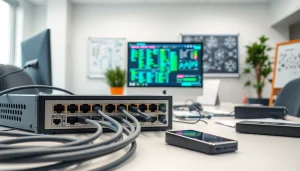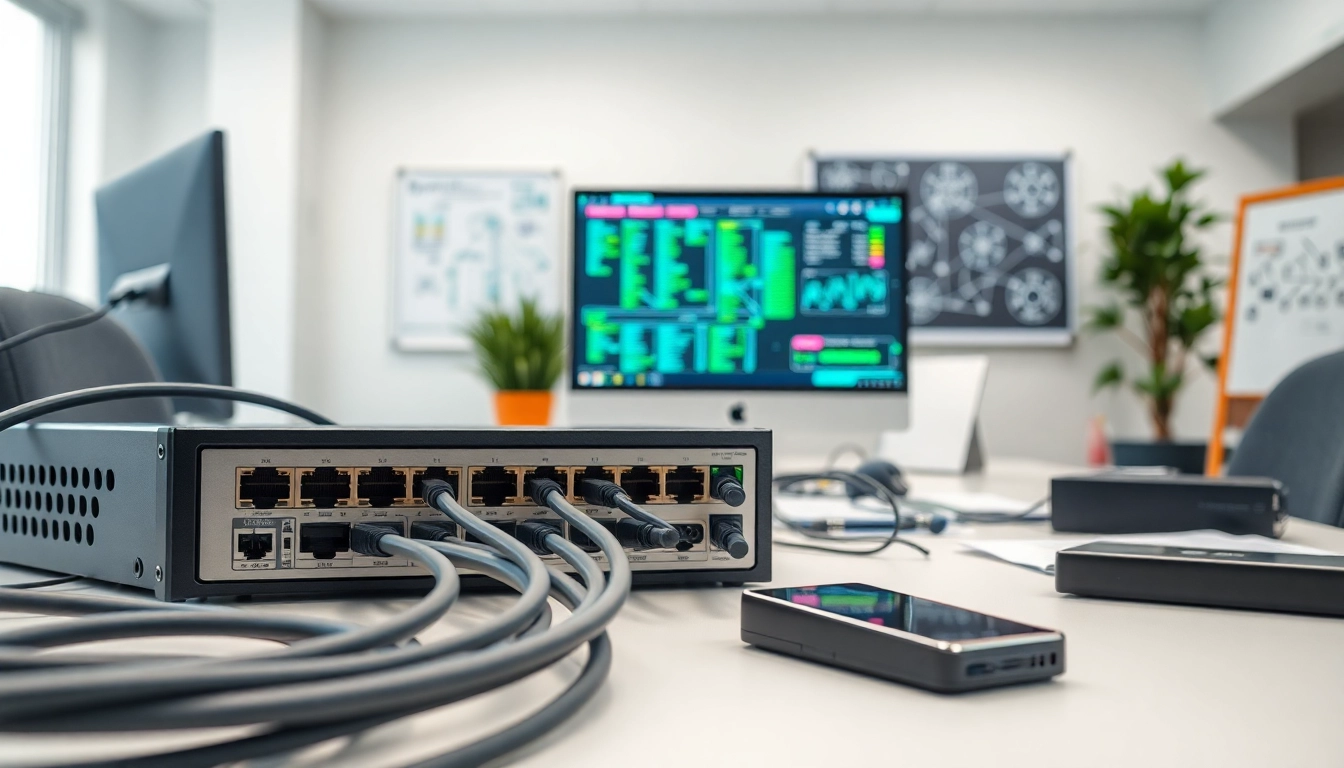Introduction to Network Switch
In the world of computer networking, the role of the Network Switch is pivotal. It’s a fundamental piece of hardware that allows various devices within a local area network (LAN) to communicate effectively. Understanding network switches is essential for anyone looking to set up or manage a network, whether for personal use or within a business context.
What is a Network Switch?
A network switch is a device that connects different devices within a network, facilitating the transfer of data packets between them. Unlike a router, which connects different networks, a switch operates at the data link layer (Layer 2) of the OSI model. It uses MAC addresses to forward data only to the device that needs it, making it more efficient than a hub, which broadcasts data to all devices on a network.
How a Network Switch Works
When a device sends data, the switch receives the data packets and reads the destination MAC address contained within those packets. The switch then checks its MAC address table to determine which port the destination device is connected to. By directing the data packets to the specific port, the switch avoids unnecessary traffic within the network, optimizing overall network performance.
Types of Network Switch
Network switches come in several types, each suited for different needs and scenarios:
- Unmanaged Switches: Basic plug-and-play devices that require no configuration. Ideal for home networks or simple setups.
- Managed Switches: Offer more control and monitoring of the network, allowing configurations such as VLANs, traffic prioritization, and port mirroring.
- PoE Switches: Power over Ethernet (PoE) switches can deliver electricity to connected devices like IP cameras or VoIP phones along with data, simplifying installations.
- Stackable Switches: Can be stacked physically and managed as a single unit, providing redundancy and scalability for growing networks.
Benefits of Using a Network Switch
Enhanced Network Performance
One of the primary advantages of using a network switch is the significant improvement in network performance it offers. By reducing unnecessary data traffic through its direct addressing capabilities, a switch enhances the efficiency of data transmission. This leads to faster file transfers, smoother streaming, and an overall increase in productivity.
Improved Data Security
Switches are inherently more secure than hubs due to their ability to segment traffic. By isolating traffic points, they minimize the risk of data breaches. Managed switches can implement additional security measures such as port security to limit device connectivity and prevent unauthorized access, providing another layer of security to the network.
Cost-effectiveness of Network Switch
While the initial setup cost of a managed switch may be higher than a hub, the long-term savings and productivity gains often outweigh the expenses. Network switches, particularly unmanaged ones, are generally more affordable and require less maintenance. Furthermore, their ability to optimize network performance reduces downtime, thus saving costs associated with lost productivity.
Choosing the Right Network Switch
Factors to Consider
When selecting a network switch, several critical factors should be considered:
- Network Size: Assess the number of devices that will connect to the switch. For larger networks, consider switches with more ports.
- Speed Requirements: Look for switches that support the required network speeds (Gigabit or 10GbE) to ensure swift data transfer.
- Managed vs. Unmanaged: Determine if you need advanced features like VLAN support and traffic management or if a simpler unmanaged switch suffices.
- Budget: Define your budget while considering not only the upfront costs but also potential future scalability.
Common Specifications
Understanding common specifications of network switches can help inform your purchasing decision:
- Number of Ports: Switches vary in the number of available ports, typically ranging from 5 to 48.
- Switching Capacity: This indicates the total amount of data the switch can handle simultaneously.
- Forwarding Rate: Measure of the speed at which the switch can forward data frames to connected devices.
- Power over Ethernet (PoE) Support: Determines if the switch can power connected devices through Ethernet cables.
Reviewing Your Network Needs
Before purchasing a network switch, it is crucial to evaluate your current and future networking needs. Consider your current number of devices and potential growth. Understanding whether you require advanced functionalities or if a simpler solution meets your needs will enable you to select the most suitable type of switch.
Implementing a Network Switch in Your Setup
Step-by-step Setup Guide
Setting up a network switch involves several straightforward steps:
- Connect the Switch to Power: Plug in the switch to a power outlet, ensuring it is compatible with your local voltage requirements.
- Connect Devices: Use Ethernet cables to connect your devices such as computers, printers, and servers to the switch ports.
- Verify Connections: Check that each device is properly connected and the corresponding port LEDs indicate an active connection.
- Configure as Needed: If using a managed switch, access its management interface to configure settings like VLANs or Quality of Service (QoS).
Common Configuration Settings
For managed switches, there are various settings you might consider adjusting:
- VLAN Configuration: Segmenting the network for security and performance benefits.
- Quality of Service (QoS): Prioritizing certain types of traffic to ensure vital applications receive the necessary bandwidth.
- Port Mirroring: Useful for monitoring and troubleshooting network traffic.
Troubleshooting Network Switch Issues
If issues arise after installation, consider the following troubleshooting tips:
- Check Power and Connections: Ensure the switch is powered and devices are properly connected.
- Verify Configuration Settings: Make sure that the switch’s settings are appropriately configured for your network requirements.
- Examine LED Indicators: Most switches have LEDs that provide information about the status of power, connectivity, and activity.
Future Trends in Network Switching
Advancements in Network Switch Technology
The networking landscape is continually evolving with several advancements on the horizon:
- Increased Port Speed: Move toward higher speeds (e.g., 25Gbps, 40Gbps, and 100Gbps) in response to growing data demands.
- Improved Energy Efficiency: New technologies focusing on reducing energy consumption without sacrificing performance.
- Smart Network Management: Tools leveraging AI and machine learning for better traffic management and fault detection.
Integration with IoT and Automation
As the Internet of Things (IoT) landscape expands, network switches will play a crucial role in facilitating connections between the multitude of IoT devices. Increased network traffic and demand for low-latency communication necessitate smarter, more capable switches that can handle the specific needs of IoT applications.
The Role of Network Switch in Smart Homes and Offices
In smart homes and offices, network switches ensure seamless communication among connected devices, reducing latency and enhancing the user experience. With the growing number of devices requiring connectivity, proper switch implementation becomes paramount for maintaining a stable, efficient network environment.

















